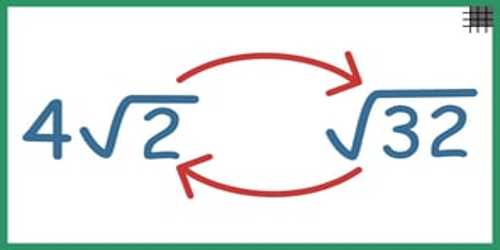Definitions of surds- A root of a positive real quantity is called a surd if its value cannot be exactly determined. It is a number that can’t be simplified to remove a square root (or cube root etc). For example, each of the quantities √3, ∛7, ∜19, (16)^2/5 etc. is a surd.
More Examples:
- √2 (square root of 2) can’t be simplified further so it is a surd
- √4 (square root of 4) CAN be simplified to 2, so it is NOT a surd
From the definition, it is evident that a surd is an incommensurable quantity, although its value can be determined to any degree of accuracy. It should be noted that quantities √9, ∛64, ∜(256/625) etc. expressed in the form of surds are commensurable quantities and are not surds (since √9 = 3, ∛64 = 4, ∜(256/625) = 4/5 etc.). In fact, any root of an algebraic expression is regarded as a surd.
Definition of Pure Surd
A surd in which the whole of the rational number is under the radical sign and makes the radicand is called pure surd.
In other words, a surd having no rational factor except unity is called a pure surd or complete surd.
For example, each of the surds √7, √10, √x, ∛50, ∛x, ∜6, ∜15, ∜x, 172/3, 595/7, m2/13 is pure surd.
Definition of Mixed Surd
A surd having a rational coefficient other than unity is called a mixed surd.
In other words, if some part of the quantity under the radical sign is taken out of it, then it makes the mixed surd.
For example, each of the surds 2√7, 3√6, a√b, 2√x, 5∛3, x∛y, 5∙722/3 are mixed surd.
More examples:
√45 = √(3⋅3⋅5) = 3√5 is a mixed surd.
√32 = √(2⋅2⋅2⋅2⋅2) = 2 × 2 × √2 = 4√2 is a mixed surd.
4√162= 4√(2⋅3⋅3⋅3⋅3) = 34√2 is a mixed surd.
Note:
A mixed surd can be expressed in the form of a pure surd.
For example,
(i) 3√5 = √32⋅5 = 9⋅5−−−√9⋅5 = √45
(ii) 4 ∙ ∛3 = 3√43 ∙ ∛3 = 3√64 ∙ ∛3 = 3√64 ⋅ 3 = ∛192
In general, x n√y = n√xn ∙ n√y = n√xny
Information Source;
















